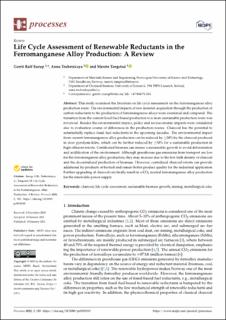| dc.contributor.author | Surup, Gerrit Ralf | |
| dc.contributor.author | Trubetskaya, Anna | |
| dc.contributor.author | Tangstad, Merete | |
| dc.date.accessioned | 2021-02-17T14:18:46Z | |
| dc.date.available | 2021-02-17T14:18:46Z | |
| dc.date.created | 2021-02-16T15:14:48Z | |
| dc.date.issued | 2021 | |
| dc.identifier.citation | Processes. 2021, 9 (1), . | en_US |
| dc.identifier.issn | 2227-9717 | |
| dc.identifier.uri | https://hdl.handle.net/11250/2728725 | |
| dc.description.abstract | This study examined the literature on life cycle assessment on the ferromanganese alloy production route. The environmental impacts of raw material acquisition through the production of carbon reductants to the production of ferromanganese alloys were examined and compared. The transition from the current fossil fuel-based production to a more sustainable production route was reviewed. Besides the environmental impact, policy and socioeconomic impacts were considered due to evaluation course of differences in the production routes. Charcoal has the potential to substantially replace fossil fuel reductants in the upcoming decades. The environmental impact from current ferromanganese alloy production can be reduced by ≥20% by the charcoal produced in slow pyrolysis kilns, which can be further reduced by ≥50% for a sustainable production in high-efficient retorts. Certificated biomass can ensure a sustainable growth to avoid deforestation and acidification of the environment. Although greenhouse gas emissions from transport are low for the ferromanganese alloy production, they may increase due to the low bulk density of charcoal and the decentralized production of biomass. However, centralized charcoal retorts can provide additional by-products or biofuel and ensure better product quality for the industrial application. Further upgrading of charcoal can finally result in a CO2 neutral ferromanganese alloy production for the renewable power supply. | en_US |
| dc.language.iso | eng | en_US |
| dc.publisher | MDPI | en_US |
| dc.rights | Navngivelse 4.0 Internasjonal | * |
| dc.rights.uri | http://creativecommons.org/licenses/by/4.0/deed.no | * |
| dc.title | Life cycle assessment of renewable reductants in the ferromanganese alloy production: A review | en_US |
| dc.type | Peer reviewed | en_US |
| dc.type | Journal article | en_US |
| dc.description.version | publishedVersion | en_US |
| dc.source.pagenumber | 19 | en_US |
| dc.source.volume | 9 | en_US |
| dc.source.journal | Processes | en_US |
| dc.source.issue | 1 | en_US |
| dc.identifier.doi | https://doi.org/10.3390/pr9010185 | |
| dc.identifier.cristin | 1890485 | |
| dc.description.localcode | This is an open access article distributed under the Creative Commons Attribution License which permits unrestricted use, distribution, and reproduction in any medium, provided the original work is properly cited | en_US |
| cristin.ispublished | true | |
| cristin.fulltext | original | |
| cristin.qualitycode | 1 | |

